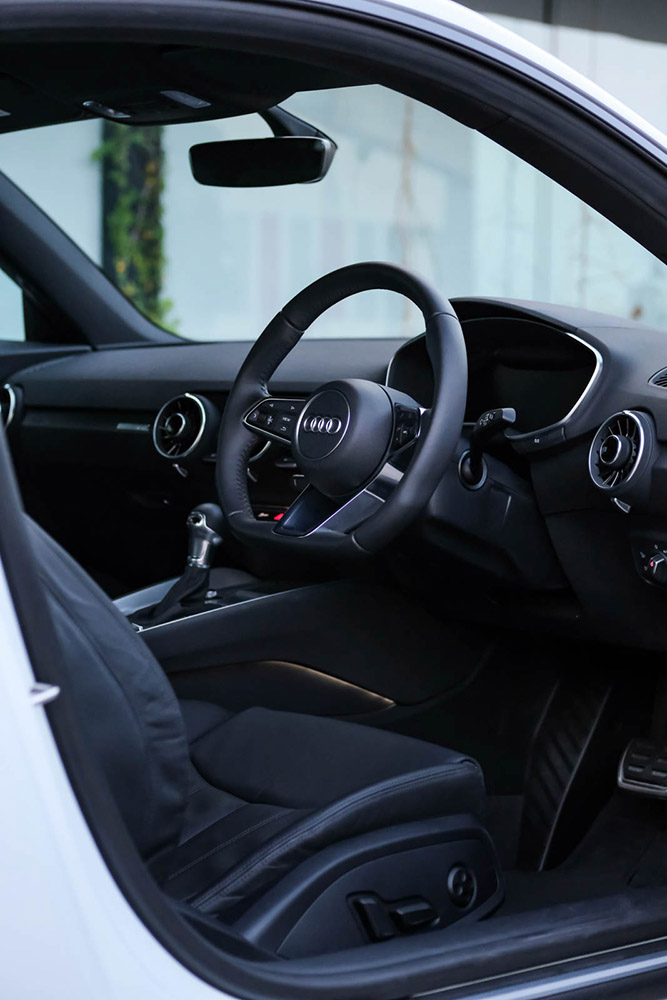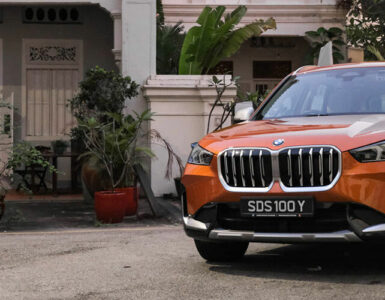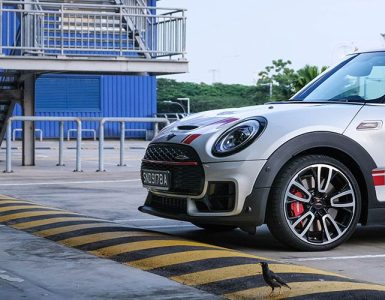A few years ago, I read On Writing by Stephen King, a book that offered writing advice in between episodic retellings of the author’s life. My lasting takeaway from the book was to edit my own writing ruthlessly, stripping away excesses, and I believe it has helped tremendously at work and in my blogging.
And according to its press release, the Audi TT follows a similar design principle, particularly for its interior: as much as necessary and as little as possible. But unlike many manufacturers who make bold claims about their products, the Audi TT lives up to the promises made by Ingolstadt’s PR flacks.

More than two decades since the original went on sale, the third-generation Audi TT coupe looks like it’s benefited from a strict diet and workout regimen that would make Henry Cavill’s Geralt of Rivia look pudgy in comparison. The results of the weight-loss programme are evident: the TT’s face is chiselled with a measure of aggression; a distinct, nearly-horizontal shoulder line runs from the front wheel arches to the tail lights to give it an athletic stance; the hexagonal Singleframe grille is almost sinewy thanks to its intricate honeycomb-like design; and the new 18-inch Y-style cast alloy rims add to the coupe’s muscular definition.
The rear view is distinctly TT in its shape, with the tailpipes in the classic dual-branch layout; the abundance of horizontal lines accentuate the coupe’s perceived width, with the front wheels placed 20mm further apart compared to the rear. The design is tastefully subtle – there are no exaggerated pseudo-aerodynamic trims to invite mockery from petrolheads.
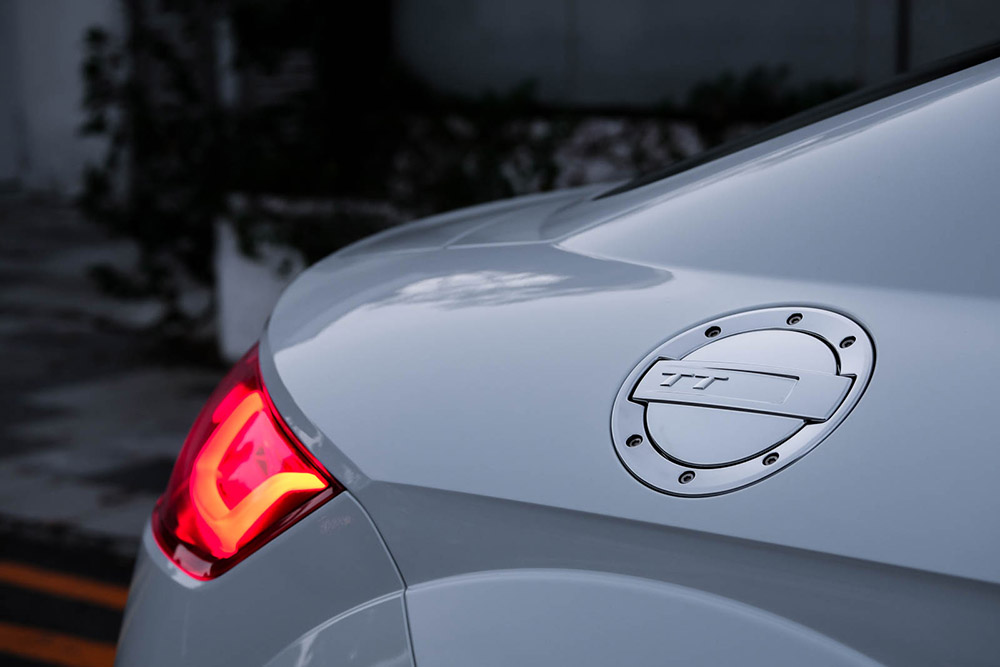
Like with previous generations of the TT, the car’s tank flap opens to immediately reveal the port underneath for drivers to directly insert the fuel pump nozzle. It’s a classic sports car feature, one that allows for quick re-fuelling in the pit lane before drivers rejoin a race.
As the sun rose to cast an amber backlight on the trees in the distance, morning joggers strode past, some looking at me – with my camera in hand – and the 1.3-tonne obstacle in their way. My privacy was gone and it was time to leave these curious onlookers behind. I climbed in the car.
The complete focus and deliberation over what is absolutely essential to create a modern driver-focused environment is unmistakable. The infotainment screen is conspicuous by its absence – just like in the R8 V10 I drove last year. It’s a confident move enabled by Audi’s class-leading virtual cockpit technology, a 12.3-inch fully digital high-resolution display presenting all the necessary information behind the steering wheel and in the driver’s field of vision. The result is an uninterrupted flow of the dashboard that is angled towards the driver; three round air vents atop the centre console – with cleverly integrated controls – add to the visual impression of a jet plane’s wing.
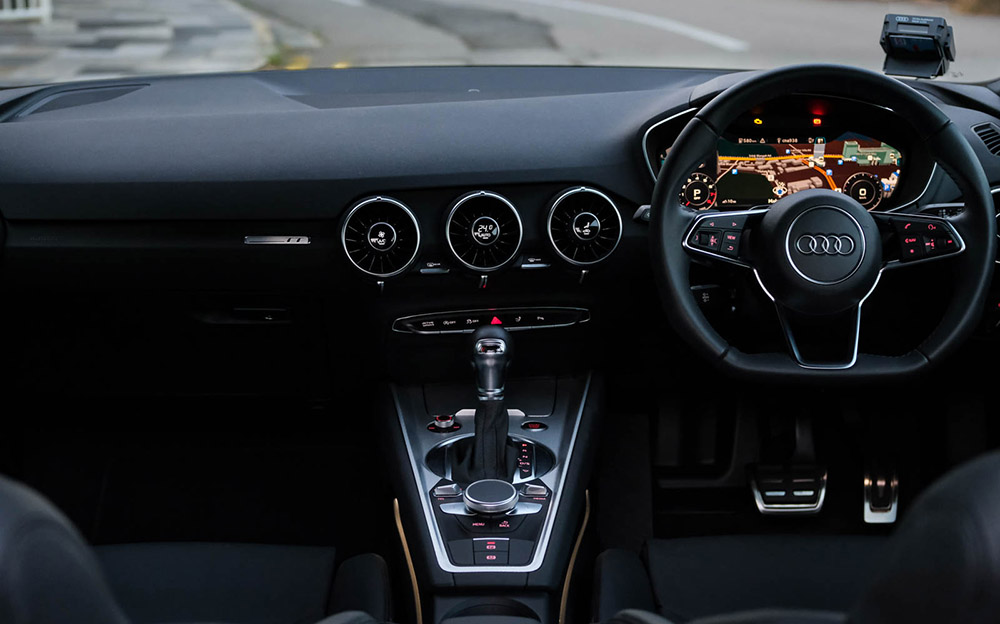
But I digress. As the engine stirred to life, I reached out to the ‘drive select’ button and bumped my forearm in the process. The gear shifter was too tall, obstructing my outstretched arm from accessing the button at the corner. It’s a minor inconvenience though, easily overcome by adjusting the angle of my arm or setting the customisable button on the steering wheel to access the driving mode menu. This was the only ergonomic grievance I had with the car, and a trivial one at that.
In its entry-level specification, the Audi TT is a blend of ride comfort (for the front occupants, anyway) and sporty aggression. It has the refinement of a compact hatchback at low speeds but can transform into a darty little runner when I set the car to Dynamic mode with the gearbox in Sport. This forces the engine to ride the torque curve in each gear before shifting up; the exhaust bellows as I keep my foot down on the right pedal, with a gurgle through each upshift in the flawlessly smooth six-speed S tronic gearbox.
The car handled the twisty roads in the west of Singapore with great composure, and I never felt my confidence waver even as the grabby Continental rubbers occasionally squealed to keep their traction. Part of this agility has to do with the fact it’s 50 kg lighter than its predecessor. According to Audi, the use of intelligent multi-material hybrid construction also gives this car 23 percent greater torsional stiffness compared to the second-generation coupe, providing it a light-footed assuredness deserving of a sports car. The nose turns quickly, given the short 2.5-metre wheelbase that is paired with a progressive steering rack. The car was easy to manoeuvre, always planted on the road and ready to go in whichever direction I pointed the front wheels.

While this 2.0-litre turbocharged unit may develop only 230 hp and 370 Nm of torque, the front-wheel driven Audi TT coupe’s 1,285 kg curb weight means the car can complete the century sprint in a brisk 5.9 seconds. Its effortless acceleration makes it easy to overtake other vehicles on the road, and its good all-round visibility means parking is usually a breeze. The sports seats in front, covered in black Milano leather, provide adequate support and cushioning to make driving long distances in this car a comfortable affair. It may not be a track car per se due to its forgiving suspension, but it’d probably still be fun to do a few hot laps in.
Previous generations of the Audi TT coupe may have invited a few cynical comments due to how they looked and drove (I’ve seen several but never had the chance to drive any), but this third instalment – driven in isolation – proved itself to be a capable sports car, albeit with some drawbacks. The rear seats have so little legroom (and headroom) that it makes more sense to fold them and expand the storage capacity beyond its original 305 litres.
That brings me to what I think might be one of the greatest competitors for the Audi TT in Singapore on paper: the Mercedes-Benz CLA35 AMG 4MATIC coupe. While I much prefer the Audi TT’s uncluttered interior, the CLA35 AMG 4MATIC, for about S$1,500 less, offers an additional 72 hp and 30 Nm of torque, a 4.7-second century sprint, an extra 155 litres of boot space, and two extra doors to very usable rear seats. It may not be a two-door coupe in the traditional sense, but there’s a lot more performance and practicality for the money.
Even if you’re dead set on a two-door sports car, considering the coupe’s rear seats are practically negligible and that the two-seater roadster’s list price is only about S$5,000 more, the top-up might be a tempting option for access to unlimited headroom without theoretically sacrificing any performance.
One thing’s for sure though: the Audi TT coupe is a sporty daily driver with a design that will age very well. Picking the Audi over the Mercedes, in this case, may come down to how much you value discretion, design minimalism, and staying away from the lunacy of overkill.
Put another way: do you believe that less is more?
Special thanks to Audi Singapore for this opportunity.
The original version of this article first appeared on Eat.Fly.Drive.
GEEK REVIEW SCORE
Summary
The third-generation, facelifted Audi TT coupe retains its defining characteristics while updating its drivetrain for a fun time behind the wheel.
Overall
7.8/10-
Handling - 9/10
9/10
-
Performance - 8/10
8/10
-
Design - 9/10
9/10
-
Comfort - 8/10
8/10
-
Practicality - 6/10
6/10
-
Value - 7/10
7/10
User Review
( votes)Alex eats a lot, travels a little, and drives cars that aren’t his on eat.fly.drive.

